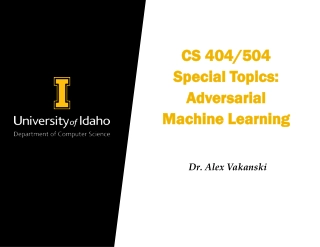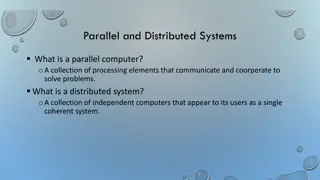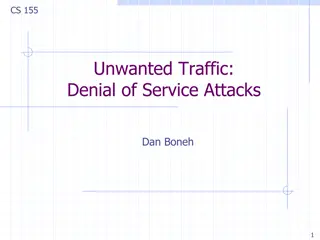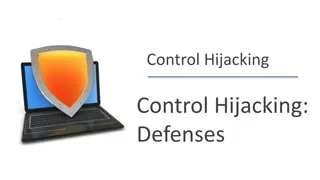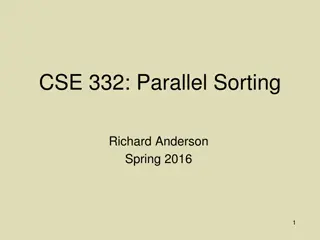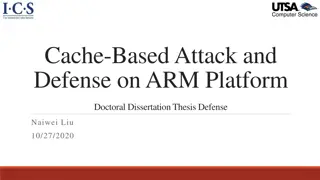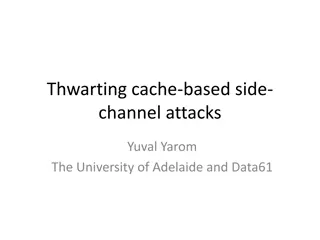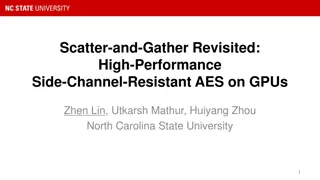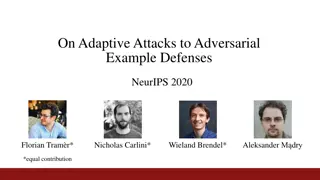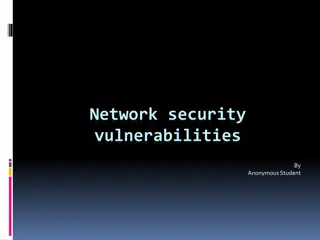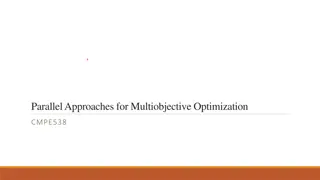Security Issues in Parallel and Distributed Computing - Side Channel Attacks and Defenses
Explore various security threats in parallel and distributed computing, focusing on side channel attacks and defenses. Learn about microarchitecture, cache hierarchy, popular attacks, defense mechanisms, and more. Discover how hardware vulnerabilities can lead to the compromise of sensitive data and encryption keys.
Download Presentation

Please find below an Image/Link to download the presentation.
The content on the website is provided AS IS for your information and personal use only. It may not be sold, licensed, or shared on other websites without obtaining consent from the author.If you encounter any issues during the download, it is possible that the publisher has removed the file from their server.
You are allowed to download the files provided on this website for personal or commercial use, subject to the condition that they are used lawfully. All files are the property of their respective owners.
The content on the website is provided AS IS for your information and personal use only. It may not be sold, licensed, or shared on other websites without obtaining consent from the author.
E N D
Presentation Transcript
SECURITY ISSUES IN PARALLEL AND DISTRIBUTED COMPUTING - SIDE CHANNEL ATTACKS AND DEFENSES Presented by: Kazi Mejbaul Islam
Outline Introduction and Background Microarchitecture Cache hierarchy Side channels in microarchitecture Threats in parallel and distributed systems Popular Side Channel Attacks An example Popular Defense Mechanisms From Software s perspective From Hardware s perspective
Introduction Hardware can not always be trusted! ISA Registers Memory Features that enhance the architecture, may be the cause of vulnerability Architecture Microarchitecture Branch Prediction Cache TLB Cache MMU Interconnection
Introduction Several threats have been created using these features such as Stealing secret encryption key Tracking browser activity Keystroke sniffing etc. We will discuss these issues and defenses from cache s cache s perspective
Background Cache architecture in Multicore Systems Cache architecture in Multicore Systems Figure 1. A dual-core dual-processor system
Background Cache Hierarchy Cache Hierarchy Hit/Miss Figure 2. Multi-level chache
Background Encryption (RSA) Encryption (RSA) RSA encryption contains c, m, e, and n represent ciphertext, plaintext, key, and the product of p and q (p, q are large prime numbers), respectively and calculates c using following equation: c memod n How do we calculate c efficiently?
Background Side Channels Side Channels Channels/mediums those are not meant to be information exchange Unlike covert channel, the victim is unconscious about the attacker. For example: Cache, TLB, power consumption Figure 3: Power consumption pattern
Threats in Distributed Systems To make computation systems massively parallel, current systems are: Multiprocessor Multicore Maintaining cache hierarchy To support multiple users simultaneously, Clouds today supports lots of VMs, containers co-locate on single architecture
Threats in Distributed Systems Attacks can take place at: Cross VM Cross container In same OS among different processes
Popular Side Channel Attacks Side channel attacks can be divided into two major types: Time Driven: In time-driven attacks, the attacker measures the total execution time of cryptographic operations to extract sensitive information Access Driven: Attacker probes the medium to infer the execution time and pattern
Flush+Reload Consists of 3 steps: 1. Flushes the cache 2. Waits for the victim to run its program 3. Probes the cache for specific instruction/data
Flush+Reload Figure 6: RSA encryption Figure 5: Flush+Reload Figure 7: Flush+Reload time flow
Prime+Probe Fills all cache line with own data Waits for victim process to get allocated and being evicted Probes the access time taken by the victim Figure 8: Prime+Probe
Example (Flush+Reload) Side-Channel Attacks on Everyday Applications by Taylor Hornby, University of Calgary Consider a scenario where Victim is going to search for pen, pencil or marker in Wikipedia. The Attacker knows that the Victim is going to search on Wikipedia and he has a list of words that the victim is going to search such as (pen, pencil, box, book, etc.) Step 1: Find the common functions that can be used to distinguish the word while searching Search each word in the list Record the pattern for each word. Suppose you have found A,B,C,D four functions.
Example (Flush+Reload) The data for the attacker may look like this: 1. Pen: AABBCDADA 2. Pencil: BCDAACCBD 3. Box: CDACDAAADCB .
Example (Flush+Reload) Step 2: Launch the attack 1. Load the program 2. Flush the cache 3. Reload A,B,C,D and record time to load If it is a hit, note that If it is a miss, omit 4. Flush again
Example (Flush+Reload) Step 3: Match with the fist recorded data The attacker will get a string like: AABCDAADCBA . Using statistical algorithm or machine learning (authors have used Levenshtein distance)
Defense mechanism How do you defend it? Attack detection Soft partitioning Page coloring Restricting fine grained time measurement Disallowing KSM Software measures Designing new cache Cache partition Attack detection Hardware measures
Attack Detection Monitor hit/miss, clock cycle, branch miss etc. Use machine learning/statistical methods to classify suspicious pattern Able to detect flush+reload and prime+probe Some researchers offloaded the detection system to dedicated hardware Cons: Requires some iterations to get data, attacker might be able to launch attack before detection Resource expensive for some applications
Constant Timing Modify the code to make the execution time abstract For example, in the RSA encryption, insert a condition for bit 0 and a constant time for both 1 and 0 bit. It makes timing information abstract Cons: Not possible to implement in all cases Creates performance overhead
Restricting Fine-Grained Time Measurements As the attacker relies on timing information and it needs to be fine-grained, kernel can limit the time measurement Cons: Measuring time at high precision is used in many softwares and making these obsolete is not a practical idea.
Page coloring Software mechanism to partition cache Color the memory pages and pages of same color can be mapped into the same cache set Cons: Not very efficient for VM. Being inherently coarse-grained it may lead performance degradation.
The Intel Cache Allocation Technology CLOS refers to one Class of Service Programs/VMs/Cores can be associated to a CLOS Program from one CLOS can not evict cache line from other CLOS Programs can get hit from all cache Figure 9: Sample CAT bitmask
Soft-partitioning Cache It is unnecessary to isolate all programs or VMs A small portion of cache can be declared as dedicated to security sensitive applications This approach can be taken from both software and hardware side
CATalyst Partition cache using CAT Use one small partition for security sensitive tasks Figure 10: CATalys
HybCache Fix last two ways for security intensive task This isolation is used for all L1, L2 and L3 cache Figure 11: HybCache architecture
Trade-off between hardware and software approach Defense mechanisms from software side can be implemented quickly to secure almost all systems Hardware approaches are more efficient but it would take a long time to be used in practice Moreover, hardware approaches would not be able to secure the existing systems
Conclusion Side channel attacks are practical for distributed systems and must be taken care of. Based on the defense mechanisms proposed by the researchers, we can conclude, a practical defense system should have: Good security Low performance overhead Able to secure existing system
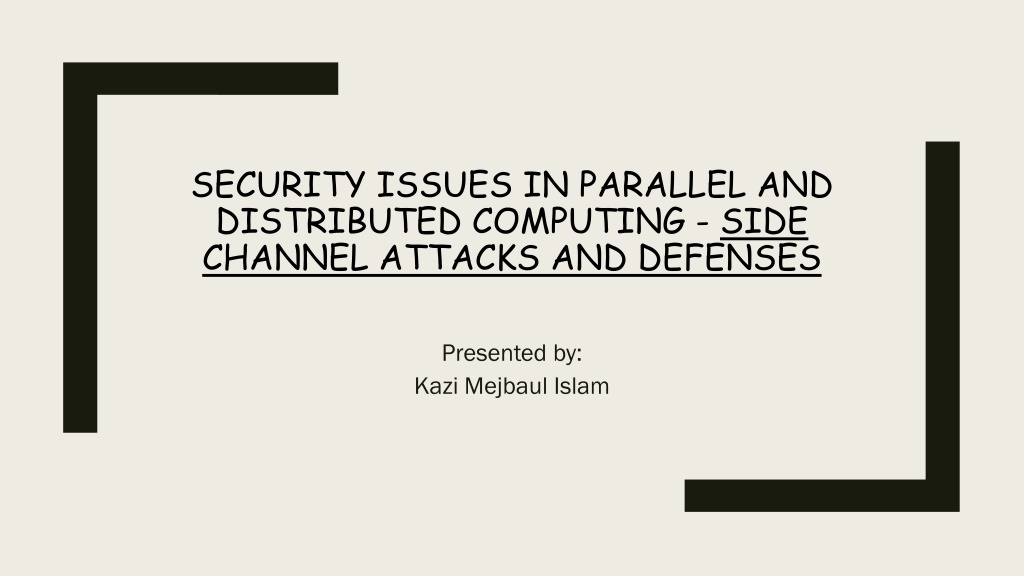
 undefined
undefined




